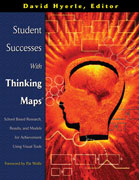



Special Education
Improving Reading Compehension Through Visual Tools
Masters Degree Thesis by Cynthia Manning
Eastern Nazarene Graduate School, 2003
Summary: Reading comprehension in learning disabled students can be increased with the classroom implementation of visual tools. Student performance was measured using MCAS reading scores before and after the introduction of Thinking Maps, i.e., a set of visual tools which are centered on the development of eight thinking processes. By integrating this common visual language throughout the school's curriculum, it was projected that more effective and efficient learning would be achieved. Assessment results indicated that reading comprehension was increased; it was also observed by classroom teachers that levels of performance rose overall in the following areas: concept attainment, reflective thinking, recall, retention, writing (quantity and quality), creativity, motivation, and cooperative learning skills. These findings are congruent with a multitude of research studies and support the position that student performance can be increased with the implementation of visual tools.
![]() Case Study: read about and view video clips on Learning Prep
Case Study: read about and view video clips on Learning Prep
![]() Download the Master's Thesis summary Improving Reading Compehension Through Visual Tools (Acrobat PDF file)
Download the Master's Thesis summary Improving Reading Compehension Through Visual Tools (Acrobat PDF file)
![]() Download the Master's Thesis Improving Reading Compehension Through Visual Tools including student examples (Acrobat PDF file)
Download the Master's Thesis Improving Reading Compehension Through Visual Tools including student examples (Acrobat PDF file)
Student Successes with Thinking Maps
Chapter 3: Leveling The Playing Field for All Students
Bonnie Singer, Ph.D.
 “Those of us who are fortunate enough to work with children often find ourselves forever changed by relationships with one or two of them. My Life took a definite turn when I met David [student Bonnie has been working with]. He taught me that the mind of an eight year old is capable of much more than I had previously thought and that even children with severe learning disabilities can learn to play the game of school as well or better than their non-disabled classmates. Through David, I learned just how powerful the Thinking Maps can be, and I saw how profoundly they can change a life. The Thinking Maps not only got David back in the academic game, but they leveled the playing field so that he could emerge as a leader in his classroom.”
“Those of us who are fortunate enough to work with children often find ourselves forever changed by relationships with one or two of them. My Life took a definite turn when I met David [student Bonnie has been working with]. He taught me that the mind of an eight year old is capable of much more than I had previously thought and that even children with severe learning disabilities can learn to play the game of school as well or better than their non-disabled classmates. Through David, I learned just how powerful the Thinking Maps can be, and I saw how profoundly they can change a life. The Thinking Maps not only got David back in the academic game, but they leveled the playing field so that he could emerge as a leader in his classroom.”
![]() read more excerpts from Student Successes with Thinking Maps chapter 3
read more excerpts from Student Successes with Thinking Maps chapter 3
Quality Assurance Project Collaboration
Resource Guide written by Judy Goldstein and participating teachers
Community School District 28, Forest Hills, NY; Distric 75, New York, NY
Summary: After a brief and practical overview of Thinking Maps, this work systematically shows how Thinking Maps have been used comprehensively and effectively across disciplines with students in the special education district that spans all burroughs of New York City. There are many examples of students' work included.
![]() Download the Resource Guide written by Judy Goldstein (Acrobat PDF file)
Download the Resource Guide written by Judy Goldstein (Acrobat PDF file)
Visualizing Thought Process Helps Students Transition to High School
 David Hyerle, Ed.D. completed graduate work at U.C. Berkeley and Harvard Graduate School of Education to investigate learning tools. As a Scholar in Residence at Plymouth State College, Dr. Hyerle consulted with Plymouth High School on the exhibit. The two video clips on the Apple Teaching Practice online professional development website are part of the online exhibit. David reflects on Thinking Maps® as a tool for transition, and speaks about Thinking Maps and self reflection. Go to the Apple Teaching Practice website to watch the video clips, as well as read and watch other parts of the exhibit.
David Hyerle, Ed.D. completed graduate work at U.C. Berkeley and Harvard Graduate School of Education to investigate learning tools. As a Scholar in Residence at Plymouth State College, Dr. Hyerle consulted with Plymouth High School on the exhibit. The two video clips on the Apple Teaching Practice online professional development website are part of the online exhibit. David reflects on Thinking Maps® as a tool for transition, and speaks about Thinking Maps and self reflection. Go to the Apple Teaching Practice website to watch the video clips, as well as read and watch other parts of the exhibit.